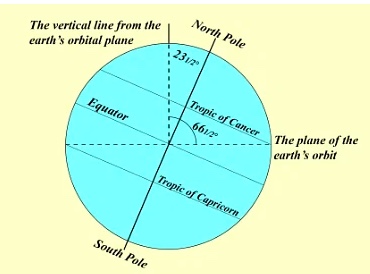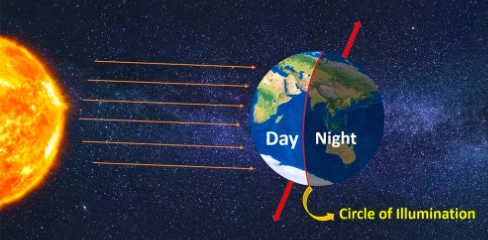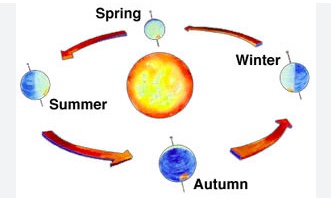Chapter 3 Notes
Motions of the Earth
Class 6 – Social Science
| Class | Class 6 |
| Subject | Social Science |
| Chapter Name | Motions of the Earth |
| Chapter No. | Chapter 3 |
| Category | Class 6 Geography Notes |
Question 1 Name two types of motion of Earth.
Question 2 Why rotation is called daily motion of the Earth?
Question 3 Why revolution is called annual motion of the Earth?
Question 4 What is orbital Plane?
Question 5 Define the term circle of illumination.
Question 6 What would happen if the Earth does not rotate?
Question 7 What is the importance of the inclination of the Earth’s axis?
Question 8 Why do we have leap year?
Question 9 What is the direction of rotation of Earth?
Question 10 What is the shape of Earth’s orbit?
Question 11 Why Christmas is celebrated in Australia in the summer season?
Question 12 Explain the phenomenon of season with help of a diagram?
Question 13 Why does the Southern Hemisphere experience Winter and Summer Solstice in different times than that of the Northern Hemisphere
Question 14 How are days and nights caused?
Question 15 What are the factors responsible for change of seasons?
Question 16 Why length of day and night is not same throughout the year?
Question 17 Differentiate between Rotation and Revolution?
Question 18 When do the longest day and the shortest night take place?
Question 19 What is the difference between the Winter Solstice and Summer Solstice?
Question 20 Where do six months-long nights and days take place and why?
Question 21 Why is the Winter and Summer Solstice experienced at different times in the Southern and Northern Hemispheres?
Question 22 What is winter Solstice?
Contents
The Earth has two types of Motions
(1) Rotation – It is the movement of the earth on its axis. The earth takes about 24 hours to complete one rotation around its axis. The period of rotation is known as the Earth day. This is the daily motion of the earth.
(2) Revolution – The movement of the earth around the sun in a fixed path or orbit.It takes 365¼ days (one year) to revolve around the sun.
The axis of the earth which is an imaginary line, makes an angle of 66½° with its orbital plane. The plane formed by the orbit is known as the orbital plane.
The earth receives light from the sun. Due to the spherical shape of the earth, only half of it gets light from the sun at a time . The portion facing the sun experiences day while the other half away from the sun experiences night.
The circle that divides the day from night on the globe is called the circle of illumination. This circle does not coincide with the axis.
What would happen if the earth did not rotate?
The portion of the earth facing the sun would always experience day, thus bringing continuous warmth to the region. The other half would remain in darkness and be freezing cold all the time. Life would not have been possible in such extreme conditions.
We consider a year as consisting of 365 days only and ignore six hours for the sake of convenience. Six hours saved every year are added to make one day (24 hours) over a span of four years. This surplus day is added to the month of February. Thus every fourth year, February is of 29 days instead of 28 days. Such a year with 366 days is called a leap year.
The Earth is going around the sun in an elliptical orbit. Throughout its orbit, the earth is inclined in the same direction. A year is usually divided into summer, winter, spring and autumn seasons.
Seasons change due to the change in the position of the earth around the sun.
(1) Summer Solstice – 21 June
(a) The Northern Hemisphere is tilted towards the sun. The rays of the sun fall directly on the Tropic of Cancer. As a result, these areas receive more heat. The areas near the poles receive less heat as the rays of the sun are slanting.
(b) The North Pole is inclined towards the sun and the places beyond the Arctic Circle experience continuous daylight for about six months.
(c) Since a large portion of the Northern Hemisphere is getting light from the sun, it is summer in the regions north of the equator.
(d) The longest day and the shortest night at these places occur on 21st June.
(e) At this time in the Southern Hemisphere all these conditions are reversed. It is winter season there. The nights are longer than the days.
(2) Winter Solstice- 22nd December
(a) The South pole is inclined towards the Sun while the North pole is turned away from the Sun.
(b) The Tropic of Capricorn receives direct rays of the sun as the South Pole tilts towards it.
(c) As the sun’s rays fall vertically at the Tropic of Capricorn (23½° S), a larger portion of the Southern Hemisphere gets light.
(d) It is summer in the Southern Hemisphere with longer days and shorter nights. The longest day and the shortest night occur on 22nd December in the Southern hemisphere.
(e) The reverse happens in the Northern Hemisphere.
(3) Spring and Autumnal Equinoxes – 21st March and 23rd September
(a) On 21st March and September 23rd, direct rays of the sun fall on the equator.
(b) At this position, neither of the poles is tilted towards the sun; so, the whole earth experiences equal days and equal nights. This is called an equinox.
(c) The North Pole and South Pole lie at an equal distance from the Sun.
(d) On 23rd September, it is autumn season in the Northern Hemisphere and spring season in the Southern Hemisphere.
(e) It is neither too hot nor too cold in both the hemispheres.
(f) The equinox coincide with the time of sunrise at one pole and the time of sunset at the other pole.
(g) The opposite is the case on 21st March, when it is spring in the Northern Hemisphere and autumn in the Southern Hemisphere.
Days and nights and changes in the seasons because of the rotation and revolution of the earth respectively.
The length of days and nights in not same throughout the year. This is due to inclination of the Earth’s axis. Due to this inclination the Northern Hemisphere remains inclined towards the Sun for half of the year and the Southern Hemisphere during the other half.
The change of season is due to
(1) The rotation of the Earth’s on its axis.
(2) The revolution of Earth around the Sun.
(3) The inclination of the Earth’s axis.
In all over the world, Christmas days is celebrated on 25 December in each year. Australia falls under southern hemisphere. In the month of December, the Tropic of Capricorn receives the direct rays of the Sun and the South Pole tilts towards it. Thus, it is summer in the Southern Hemisphere at this time and hence Australia celebrates Christmas in summer season.





Leave a Reply